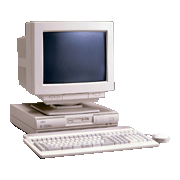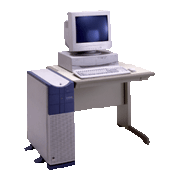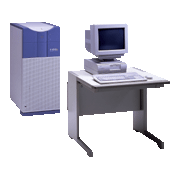The Fujitsu K-6000α series of office computers was the successor to the K-6000 series. Together with the K-1500α series of office workstations, Fujitsu announced nine lines and 26 models*1 in November 1994. The K-6000α series was positioned as business servers*2 that provided client-server work environments by networking PCs and servers together. In terms of features, the K-6000α series extended the substantial functional upgrades*3 made to the K-6000α series in October 1993.
Features of the K-6000α series:
- (1) Field upgradable
- (2) New BS*NET software
- (3) Enhanced processors and more main memory capacity and disk capacity
The following features apply to all models except the K-6500α DT models:
- (4) All models were standard equipped with mirrored disks
- (5) Connectable to 100 Mbps high-speed LANs that support the fiber distributed data interface (FDDI)
- (6) Standard equipped with a 230 MB double-density magneto-optical disk drive
- *1. The K-6000α series consisted of three lines and 13 models (see table below). The K-1500α series consisted of six lines and 13 models (K-1300α/10, 30; K-1600α/10, 20, 30; K-1600αNB/05, 10; K-1600αNX/05, 10; K-1600αLT/10, 20; K-1600αLX/10, 20).
- *2. Fujitsu’s generic term for business-use servers including office computers and UNIX servers. The K-6000α series shared a cabinet design with the DS90/7000 series of UNIX servers. Fujitsu began using the term business server in October 1993 with the K-6000 series upgrades.
- *3. These upgrades included the joint use of a proprietary 64-bit RISC architecture and the previous CISC architecture and enhanced PC connectivity software (the RDA/SV remote database access software, etc.) and were seen as the precursor to the K-6000α series.
Fujitsu continued to make upgrades to the K-6000α series until November 1996.
| Line (model names below) | K-6500α | K-6700α | K-6900α | |||||||||||
|---|---|---|---|---|---|---|---|---|---|---|---|---|---|---|
| DT | I | II | III | IV | V | I | II | III | IV | I | II | III | ||
| Introduced | November 1994 | |||||||||||||
| No. of CPUs | 1 | 1 | 2 | 3 | ||||||||||
| Main memory capacity | 8MB − 16MB | 8MB − 128MB | 32MB − 2920MB | 64MB − 512MB | ||||||||||
| Disk capacity | 973MB − 1.9GB |
973MB − 25.0GB |
1.9GB − 165.8GB |
3.0GB − 293.8GB |
||||||||||
| Max. number of directly connectable workstations | 6 | 112 | 336 | 896 | ||||||||||
| Max. number of LAN connectable workstations | 1024 | 2048 | ||||||||||||
| Max. number of communication lines | 3 | 49 | 89 | 128 | ||||||||||
| Operating system | ASP | |||||||||||||
| Other details |
|
|||||||||||||
*1. RISC: Reduced instruction set computer.
*2. CISC: Complex instruction set computer.
The specifications above were correct at the time the products were announced. Some specifications were later revised due to product upgrades.




